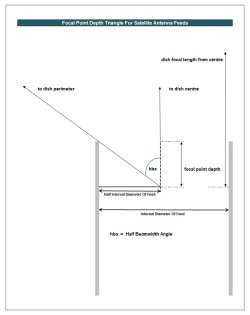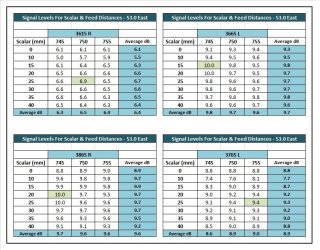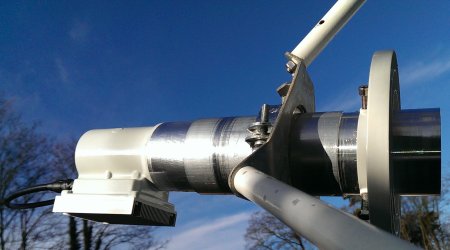I am compelled to reply. There seems to be a bit of fuzziness on the scalar subject. And please accept my personal experience from quite a few "bringing back to life" of old prime focus dishes.
You should shy away from lnbf and flange combinations if the feed throat depth cannot be adjusted separate from the scalar position.
You would think that every dish will be a perfect parabaloid. Unfortunately it is not so.
In a ideal world a 4 meter dish would set perfectly inside of a 5 meter dish, a 3 meter inside of that. And so on. But it may not be so unless you have dishes by the same manufacturer or those who manufacture to strict design specs. Andrews, Prodelin, milspec., etc. They do.
There are calculations where stretching strings across a dish face and measuring the diameter and center depth. And determining the f and f/D.
Then you know where a scalar should be positioned and where the feedhorn throat should be set in relation to the dish center.
Again. Only for a perfect parabolic shape.
Try to think of an artificial solar or lunar eclipse. You hold a disc in front of your eye and move it out or in until you see only the very edge of the moon or sun.
The perfect position for a scalar is where you're not "blinding" a portion of the diameter and not exposing more than the diameter. Get it?
Then. Moving the lnbf throat in or out for signal peak. While retaining proper skew angle. And assuring the throat points at the exact dish center.
So as you should see. A fixed lnb/flange may not let you experience the best performance you could.
In my image. At the initial setup of a c band scalar and lnbf for c band.
The f & f/D calculations were performed. Everything was bolted in place per the results. The lnbf was peaked for signal.
Although the calculations and lnbf spec sheet said to set the f/D to, let's say, 30. Actual signal peak was when the throat was a bit closer to the dish face.
The photo is from setting up an adjustable scalar depth method by the way of long bolts and lock nuts.
When finished, everything that looks off-kilter was perfectly aligned ans well as could be.
The Geosat Pro ku banf lnbf "sidecar" setup is there and looks offset. I have a buttonhook feed with the extension arm bolted to an aluminum casting at the dish face.
Aiming the ku lnbf at the center of the dish killed a portion of the signal. So an offset of ~5 degrees East was found the be a good placement.
And even though the ku lnbf is on a 12' dish. It only sees a little over 1m of it.
That is where a proper lnbf/scalar would be much better. There are tricks where people are removing the weather shield from the front and cutting off a portion of the built in scalar.
As the lnbf is for an offset feed dish, its appearance is indeed a cone. As opposed to a flat face scalar of the c band one.
There is mention of waterproofing. Not a bad thing. But I believe a little breathing necessary too. There are feed boots out there. For my amateur radio coax connections I use clear Flex Seal. Over 6 years on a few connections in the tower and still working great. Nothing fancy, no Coax-seal self amalgamating tape. Perhaps mask off a flange and give it a few coats and call it a day. And save the rest of the can to make a screen door boat.
Not looking for negative replies on this one guys. I've done it quite well so far. And it took a few tries to get there. Now its repeatable and works perfect.
Feed











